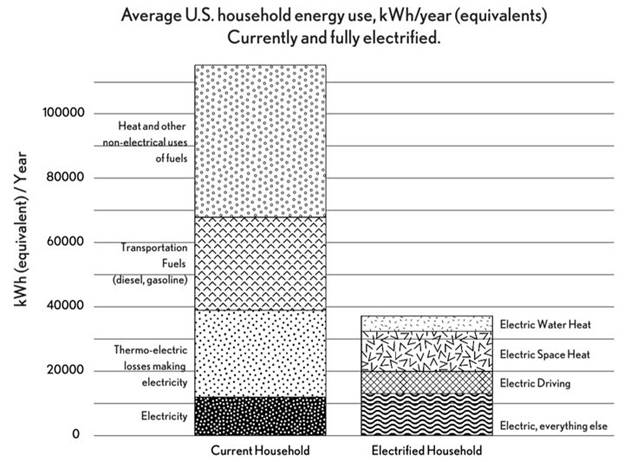Imagine a world where everything needing a power source runs on electricity. Lots of things in our daily lives already fit this mold – our lights, phones, TV sets and washing machines. But what if we switched to electricity for everything else – our cars, home heating systems, cooking appliances, even our lawn mowers?
Would it cost more to live this way or diminish our quality of life? Would it benefit the environment?
The answer may surprise you. If solar and other non-carbon energy sources powered everything, the average U.S. household could save up to $2,500 on its annual energy bill – without imposing any real lifestyle changes. Better still, our nation’s total energy requirements could be cut in half, power sector carbon emissions could fall to zero in 15 years, and 5 million permanent jobs could be created over the long term. That’s s more jobs than our energy sector currently employs.

That’s the headline finding of a new report called Mobilizing for a Zero Carbon America by Rewiring America, a non-profit group focused on rapid decarbonization of our nation’s economy. The leader of this group and report co-author, Saul Griffith, is a MacArthur “Genius Award” fellow. Co-author Alex Lasky is a clean energy entrepreneur.
The genius of their analysis is that it takes full advantage of the inherent efficiencies of renewable power generation compared to competing forms of thermal energy. For example, only 34%-44% of the carbon fuel in a coal- and gas-fired power plant ends up as electricity flowing into the grid. Much of the rest is lost converting water into steam and turning it back into water again.
Vehicles are even less efficient in their use of carbon fuel. Only about 12%–30% of the energy in an internal combustion engine actually goes to moving a vehicle down the road. The rest is lost to engine and driveline inefficiencies or is otherwise diverted to a vehicle’s power accessories.
While the best solar panels on the market still are only about 25% efficient, their “fuel” is the sun – with no attendant fuel costs or carbon emissions. As solar conversion efficiencies continue to climb higher and production costs achieve mammoth economies of scale, solar is now poised to beat new fossil-fuel and nuclear plants on total operating costs. Solar’s remaining obstacle is its intermittent energy source that depends on sunlight. But with battery prices also dropping fast, the pieces are falling into place to realize an all-electric future, driven by solar.
The challenge now is convincing the American public to rally behind this clean energy revolution. That’s where the folks at Rewiring America provide some helpful insights. According to their new report:
- Half of the nation’s total energy needs would simply disappear if we electrified most sectors of our economy.
- Seventy percent of the necessary emission cuts would come from electrifying the transportation and building sectors as well as parts of heavy industry.
- The residential sector would take care of most of the rest, but simple home weatherization measures won’t do. Real step changes come from replacing home furnaces and water heaters with electric heat pumps, using electric-induction ranges in place of gas for cooking, and trading in gasoline-powered vehicles for new, all-electric ones.
- With the help of Internet-connected batteries, smart inverters and charging stations, all of these devices will communicate with each other and bring stability to the grid.
Under the goals of the Paris climate accord, one luxury we don’t have is time! Griffith and Lasky believe the country should mobilize a war-like effort immediately to ramp up production of renewables, electric vehicles, batteries and heat pumps. All of this manufacturing and deployment would create 25 million well-paying jobs over the next 3-5 years, distributed all across the country, with five million jobs sustained over the longer term in service of this electrified infrastructure.
While consumers would benefit from lower energy bills, saving $1,000-$2,000 a year on average, they would still face some up-front investments that are beyond what’s found in most home energy budgets. That’s where new low-interest “climate loans” would come in to help speed this energy transition.
Rewiring America estimates that the federal government’s share of this financing would be $300 billion a year for 10 years, mostly in the form of consumer incentives and loan guarantees. The lion’s share of funding would come through conventional lending mechanisms in the private sector that earn market-based returns.
In the end, this rewiring of America could be a win-win for our homes, our country and the environment. Our homes would become more comfortable and cheaper to operate with cleaner and more reliable power. At the same time, the U.S. could become more prosperous and resilient, achieving a healthier and more equitable living standard for all of its citizens.
For a graphics-friendly synopsis of how Rewiring America aims to achieve a zero-carbon economy, watch this 11-minute video from Vox.
Solaflect Energy is your home energy management partner to help you navigate a future that’s coming at us faster than ever – and the only local solar company still taking new customers in 2020 to capture the federal tax credit for solar before it declines December 31st. Contact us, check out our offerings and get involved!




